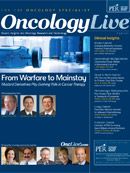Emerging Biomarker Science Presents Practical Questions
Although the use of tumor markers to evaluate patients with breast cancer is well established, the nuances involved in such testing are growing along with the emergence of novel assays and fresh research findings.
Debu Tripathy, MD
Co-Leader, Women’s Cancer Program
Professor of Medicine
Priscilla and Art Ulene Chair In Women’s Cancer
USC/Norris Comprehensive Cancer Center
University of Southern California
Los Angeles, CA
Although the use of tumor markers to evaluate patients with breast cancer is well established, the nuances involved in such testing are growing along with the emergence of novel assays and fresh research findings.
Debu Tripathy, MD, has made novel therapeutics in breast cancer the focus of his clinical research. He is delving into biomarkers that predict sensitivity and resistance to therapeutics, as well as growth factor receptor pathways that might be promising candidates for targeted therapies.
In this interview, Tripathy discusses practical implications of biomarker research.
How do you use gene profiling in clinical practice?
The primary area where gene profiling such as the Oncotype DX score helps is in patients who have estrogen receptor (ER)—positive or progesterone receptor (PR)–positive and HER2/neu—negative early-stage cancers.
It is primarily used in patients with negative nodes because in those patients the benefit of chemotherapy on the average is very small. Those with a high or intermediate-to-high recurrence score—perhaps a little more than a quarter of the patients—derive almost all of the benefit of chemotherapy, and most of the other patients do not.
More recently, there have been some studies to suggest that maybe in patients with positive nodes, even though the risk of recurrence is higher, the recurrence score may still tell us who is likely to benefit from chemotherapy. There may even be patients with positive nodes who really don’t benefit much from chemotherapy. The studies supporting that are not as robust, so that area is a little more controversial.
In fact, there’s an ongoing prospective study right now for patients with one to three nodes and hormone receptor—positive, HER2/neu—negative tumors to use the Oncotype assay and randomize those who have a score of less than 25 to hormonal therapy alone versus chemotherapy followed by hormonal therapy. In that study, patients with a recurrence score greater than 25 automatically get chemotherapy.


The HER2 gene is amplified in 20% of breast cancers (top). The extra HER2 proteins increase the activation of the cancer cell-signaling pathway (bottom).
How do you use biomarkers when tumors recur?
When patients have a local or distant recurrence, the standard now is to do a biopsy if feasible and send these biomarker assays because the markers can change.
For estrogen and progesterone receptors, they may change up to 10% to 20% of the time. For HER2, it’s probably less, maybe in the 5% to 10% range, but it is important in decision making. It may affect the therapy options that you would have in recurrent disease.
Many times, biomarkers from the original tumor that may have been determined years earlier are used, and we now know that sometimes those can change and affect tumor biology.
What role does tumor heterogeneity play?
Tumor heterogeneity is becoming an increasingly recognized phenomenon, and it’s very difficult to incorporate that into decision making. As the tumors grow, different cells within the tumor may start to acquire or select for different genetic changes, and then a certain part of the tumor may grow, expressing a different set of proteins than another part of the tumor. If you’re giving the patient a drug that might select out one of these subclones, you end up getting differences in markers across the tumor due to selective pressures.
Now we’re seeing that when we perform estrogen, progesterone receptor, or HER2 analysis, we may find that the whole tumor doesn’t behave uniformly.
It’s still a controversial notion, but we do know that tumor heterogeneity exists, and now the problem is how do we deal with it, how do we use that information? Certainly, it is not something we’re routinely using. If you look at all the guidelines for how a pathologist should score ER, PR, or HER2, it’s by counting a lot of cells and then averaging them. There really isn’t accounting for these sorts of patches over larger segments of tumor. What do you do if you have just a small patch of HER2—positive cells and the rest of the tumor is HER2–negative? Should those patients get trastuzumab?
These are questions that we simply cannot answer at the moment. So tumor heterogeneity is an evolving area. We think it’s a very interesting window of opportunity to learn about mechanisms of resistance in the research setting. But for clinical decision making, it is really bedeviling us.




